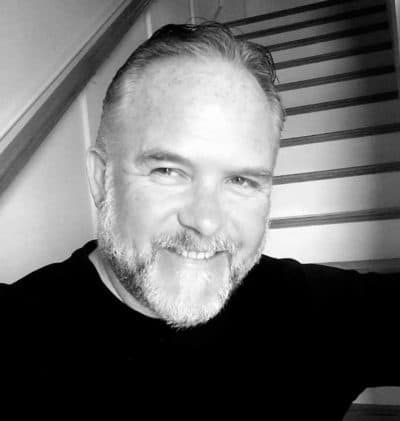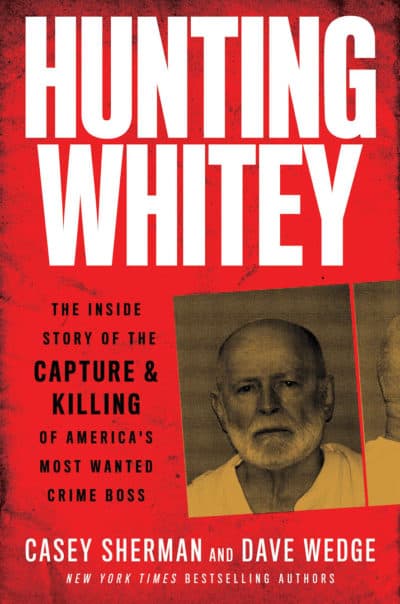Advertisement
'Hunting Whitey' Tells Saga Of The Capture And Murder Of Infamous Crime Boss
The sordid tale of Whitey Bulger — Boston’s most notorious gangster — has been told and retold many times in magazine articles, in books and in movies. But Boston-based authors Casey Sherman and Dave Wedge believed the full story had not yet been written, especially that final chapter on his capture, imprisonment and murder in prison.
“We don’t look at it as one more Bulger book,” says Sherman, on the phone. “We really look at it as the exclamation point in the Whitey Bulger saga.”
The duo’s latest effort, “Hunting Whitey: The Inside Story of the Capture & Killing of America’s Most Wanted Crime Boss” is out now.

The authors pose these questions, among others: What was Bulger’s life on the lam like and who enabled him? What role did his younger brother William play? How did the once-corrupt and long-derided Boston FBI finally crack the case? How did Bulger get to his final destination, that federal prison where he was killed less than 24 hours after his arrival? Who killed him and why?
When you peruse the book’s jacket, you’ll see an old man’s familiar visage. He’s bald, white-bearded and looks fairly benign.
Occasionally, he was.
“But being nice is a great way to use people,” says Sherman. “He was a brilliant manipulator of human nature. Although we focus on Whitey in his ‘lion in winter’ phase, an aging fugitive, we had to go back and look at his past. That’s what he was reminiscing about, too, while he was spending 16 years on the run. [When writing] you have to just articulate and accent the menace that was Whitey Bulger during his reign of terror in South Boston from the mid-1970s to the early 1990s.”
Sherman says when he was a younger man — going to Boston University in the early ‘90s and living in South Boston — he bought the Bulger myth, believing “he was this James Cagney-like gangster keeping the drugs out of South Boston. It was a great image and a Hollywood-driven image of this guy. Only years later did I realize the true extent of what he was doing, polluting a whole generation of people in South Boston and leveraging his brother’s political weight to carve his own niche in the Boston underworld.”
For Bulger, there was a long litany of crimes: Hard drug dealing, assaults, murders. And he was a rat for sources at the FBI, which tipped him off numerous times and prompted his escape from Boston to, at the time, parts unknown.
Sherman and Wedge have been a formidable team over the past five years. They co-wrote “Boston Strong: A City’s Triumph Over Tragedy,” about the Boston Marathon bombing, which was adapted for the Mark Wahlberg film “Patriots Day.” They also wrote “Ice Bucket Challenge: Pete Frates and the Fight Against ALS,” which is in development as a feature film, and the New York Times bestseller “12: The Inside Story of Tom Brady’s Fight for Redemption.”
For this book, their fourth, Sherman mostly wrote about Bulger’s criminal history and when he went on the run, after the FBI tipped him off. Wedge picked up on the trial and Bulger’s life (and death) in prison. “We edit each other and that makes it flow,” says Wedge.

Sherman and Wedge have several “gets”: Correspondence from and information on Bulger’s accused murderer, Freddy Geas; a face-to-face interview with William Bulger, Whitey’s younger brother and the former state senate president and ex-president of UMass, who has always been recalcitrant, at best, to talk about his younger brother; an interview with convicted arms smuggler and Bulger associate Pat Nee; and interviews with several federal agents who tracked the gangster for years, determined to convince the public they hadn’t dropped the ball.
Wedge says he met Nee, after he’d served his time, in a South Boston sub shop. “He probably killed several people,” says Wedge, during a separate phone interview. “He’s out walking around the streets, a free man, and he kind of made it like [his crime life was] ‘That’s the old me, I’m a grandfather now.’ A lot of them relive their glory days, but remember, these people are criminals so they’re reliving things their way, telling you their version of the truth. You have to take it with a grain of salt.”
The authors corresponded with Geas several times by letter and spent face time with his daughter Taylor who, says Wedge, “was a great resource and provided a lot of incredible stories about her dad. He was a Springfield mobster and he was really not unlike Whitey — he could work for the mob and do things for the mob but he could never be in the mob because he wasn’t Italian. He was Greek.”
Geas, serving time for murder, did not have a history with Bulger, but Bulger killed women and that offended Geas’ code of honor. Also, one of his friends was put behind bars for years because of false information Bulger had given authorities. “There’s a lot of people who think that was a big motivating factor [in the Bulger killing],” says Wedge. “In addition to the fact that Whitey was the ultimate rat — he took down the Italian mafia in Boston and they put him in a prison with a bunch of Italian mobsters.”
“While no one is shedding a tear that Whitey Bulger is no longer on the planet, I’m not really in favor of de facto death penalties,” adds Wedge. “The prison system has an obligation where they should make sure their population is safe and there were a lot of questions here about whether that was done. He was a frail 89-year-old invalid and he was sent to the worst federal prison in the system. It was clear, at the very least, it was incompetence and at the worst, there was foul play involved.”
On the other hand, FBI special agent Charlie Gianturco told the authors he “relished” Bulger’s death, saying, “You live by the sword, you die by the sword. He then corrected himself. "It makes Whitey sound valiant, like a f---ing knight. He was a slug, a killer of women. There's nothing valiant or romantic about that."
Sherman says that the FBI felt they were chasing Bigfoot. “No one believed — even people within the FBI — that they would ever catch Whitey Bulger,” Sherman says. “And I love the fact that it a was a female FBI agent named Noreen Gleason, who I interviewed extensively, who really shifted the paradigm in the case and applied focus on [Bulger’s girlfriend] Catherine Greig as opposed to Whitey Bulger. That was the breakthrough.”
What happened was the FBI located a plastic surgeon who’d done work on Grieg and had photos of her in his files. When those photos became part of a “Where’s Whitey?” TV ad, Anna Björnsdóttir, a woman who used to live near the couple in Santa Monica, California, phoned in and said it looked like the woman she knew as Carol Gasko, who she’d seen out taking walks with her husband, Charlie.
That set the wheels in motion, leading to Bulger’s capture in the basement of the Santa Monica apartment building in which he and Greig had anonymously lived.

After his conviction in Boston, Bulger served time in U.S. penitentiary Coleman II in Florida. His move to the federal prison in Hazelton, West Virginia was one big bungle, the authors write, but not a concerted plot. “It wasn’t a vast conspiracy to set him up,” says Sherman. “It was a confluence of different events.”
Wedge calls it an “end-around.”
Bulger had a dispute with a nurse in Florida, a close friend of the warden, who got him shipped out. Bulger was classified as being at high medical risk, but they lowered his status to allow for the transfer.
“He’d been on a [respirator], had an oxygen tank,” says Wedge. “He’d had multiple heart attacks and was hardly walking at that point. There’s a lot of unanswered questions about why that was allowed to happen, and when you read the book, I think what you’ll find out is a combination of negligence and I don’t want to say corruption but … I don’t think somebody said ‘Let’s put Whitey Bulger there and make sure he gets killed.’ But I think no one really cared what was going to happen when he went there. There are investigations that still haven’t played out yet, but the farther we get away from the act the easier it is for the prison system to just ignore it and hope it goes away.”
William Bulger does not come out smelling like roses. It’s long been posited that the former politician had been in much more contact with Whitey then he let on and knew lots more about Whitey’s whereabouts. (Before Congress, William Bulger testified he’d spoken to his brother only once.) Wedge was acquainted with William from his years covering politics for the Boston Herald, and had been dogging him for some time while researching “Whitey,” knocking on his door “like the old days.”
He had gotten no answer until the day he did. “It was weird,” Wedge says. “It was almost like he was waiting for me. He opened the door and said, ‘Hello David, how are you? Come in.’”
They sat in the kitchen and talked for two hours. “He opened up and told me a lot about his life with his brother and how he thinks they took divergent paths,” Wedge says. “He expressed the sentiments that while there was a karmic aspect about what happened to his brother, that was a pretty bad way to go and it’s not right if the government is putting him in harm’s way.”
Wedge says he felt he needed to be respectful to get him talking at all. “If I had said, ‘Come on, that’s bulls---, everyone knows you talked to him all the time,’ he would have said, ‘You know, I’m going to ask you to leave.’ I knew where the line was. What I wanted most from him was the personal side of their story: With these two brothers, how did he go one way and you the other?”
Sherman and Wedge will be back in December with another book, this one a collaboration with mega-selling author James Patterson, “The Last Days of John Lennon.” It will coincide with the 40th anniversary of his assassination. “We interviewed so many folks connected to the case and dug through the original court files,” Wedge posted on Facebook. “Very humbled and proud of this one.”
